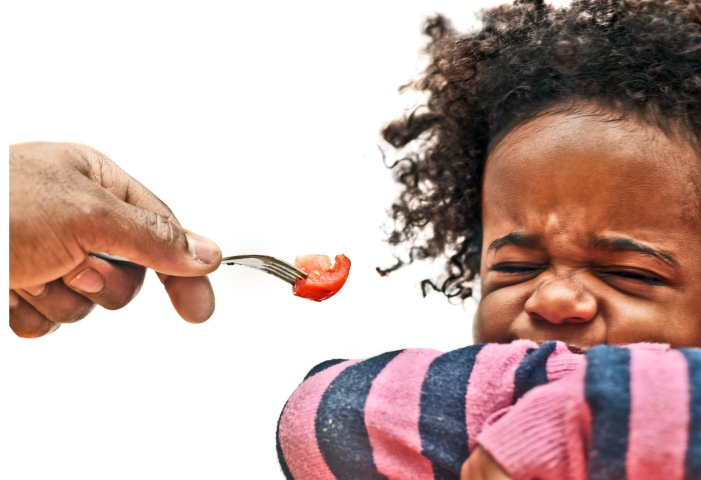Are you struggling with your toddler’s messy food-throwing habit? This common yet frustrating behavior is a phase most parents navigate during early childhood.
Our article will equip you with effective prevention strategies and practical steps to handle this challenging scenario.
Let’s dive into this ultimate guide and turn your mealtime chaos into peaceful family moments!

Prevention Strategies for Food Throwing
To prevent toddlers from throwing food, consider their developmental expectations and demonstrate proper eating behavior.
Use a plastic mat under the highchair, have the child sit at the table, eat together, limit food on their tray, offer a “no thank you” bowl, keep pets away, avoid pressuring them to eat, establish a meal schedule, and introduce baby sign language for better communication.
Be mindful of developmental expectations
Understanding your toddler’s developmental stage is crucial when managing food throwing. Toddlers continuously learn and experiment, sometimes through mess-making activities like throwing food.
Remember that a one-year-old still lacks the motor skills to consistently use utensils or eat without spilling, while an older toddler might be testing boundaries.
This awareness can help parents set realistic expectations and respond more patiently to their child’s behavior.
The key lies in choosing strategies catering to your child’s development level, turning mishaps into teaching moments rather than stressful encounters.
Model proper eating behavior
One effective strategy in preventing toddler food throwing is to model proper eating behavior. Toddlers learn by observing and mimicking the actions of those around them, so parents and caregivers need to set a good example during mealtimes.
Sit down at the table with your child and demonstrate how to eat calmly without throwing food. Use utensils, chew with your mouth closed, and show enthusiasm for trying different foods.
You can help your child develop healthy habits and decrease the likelihood of food-throwing tantrums by showing your child what appropriate mealtime behavior looks like.
Use a plastic mat under the highchair
A plastic mat under the highchair can be a helpful tool in preventing food throwing. It provides a barrier between the child and the floor, making cleanup easier. Here are some benefits of using a plastic mat:
- Protects your floor: A plastic mat creates a designated area for mealtime mess, preventing food from directly landing on your floor. This step helps to protect your flooring from stains, spills, and crumbs.
- Easy cleanup: With a plastic mat in place, you can wipe or rinse away any food that falls onto it. This saves you time and effort in cleaning up after each meal.
- Encourages independence: By containing the mess within the boundaries of the mat, you allow your toddler to explore their food without worrying too much about creating chaos. This will promote their independence and self-feeding skills.
- Reduces stress: Knowing that you have a protective layer under the highchair gives you peace of mind during meals. You can relax and focus on enjoying family time rather than constantly worrying about spills and stains.
Sit the child at the table instead of using a highchair tray
- Place the child directly at the table for meals rather than using a highchair tray.
- This makes them feel more included at mealtime and promotes better eating habits.
- Sitting at the table helps the child learn proper manners and socialize with family members.
- Sitting alongside other family members makes children more likely to model their behavior and develop good eating habits.
- It also reduces the temptation to throw food as there is no barrier between them and the rest of the table.
Eat with the child

One effective strategy to prevent toddlers from throwing food is to eat with the child. Sitting down and enjoying a meal together sets a positive example for your little one.
They are more likely to imitate your behavior and develop good eating habits. Make mealtime a pleasant experience by engaging in conversation, making eye contact, and showing enthusiasm for the food on your plate.
This action encourages healthy eating and minimizes their chances of tossing their food around. By modeling proper eating behavior and sharing this enjoyable time with your child, you can help curb their urge to throw food during meals.
Put less food on the child's tray
Putting less food on the child’s tray can help prevent food-throwing incidents. Here are some ways to do it effectively:
- Serve smaller portions: Give your child smaller food portions at each mealtime. Reducing the likelihood of excess food being available for throwing.
- Offer one type of food at a time: Instead of presenting a variety of foods all at once, offer one type at a time. This allows your child to focus on eating that particular food without feeling overwhelmed or tempted to throw it.
- Serve manageable portions: Avoid overfilling the child’s tray with too much food. Remember that toddlers have small stomachs and may become overwhelmed with excessive food in front of them.
- Gradually increase portion size: As your child becomes more skilled at self-feeding and demonstrates responsible behavior, you can gradually increase the portion sizes to match their growing appetite and development.
- Use snack-sized containers: Consider using small containers or plates to serve meals and snacks. This helps control the amount of food available and makes it easier for your child to manage without the urge to throw in excess amounts.
Provide a "no thank you" bowl
A “no thank you” bowl can be valuable in preventing food throwing during meals. Here are some tips on how to effectively use this strategy:
- Place a small, empty bowl on the child’s tray or table.
- Explain to the child that if they don’t want to eat a particular food, they can politely place it in the “no thank you” bowl instead of throwing it.
- Encourage the child to communicate their preferences by using words or gestures when they don’t want to eat something.
- Praise and reinforce positive behavior when the child appropriately uses the “no thank you bowl.”
- Avoid making a big deal out of food refusal or rejection. Respect the child’s choices and provide alternative options.
Keep pets away during meals
Pets can often be a distraction during mealtimes, especially for curious toddlers. Keeping pets away from the dining area when your child eats is essential to prevent throwing food.
While many children may find sharing their meals with their furry friends fun, this can lead to a messy and chaotic mealtime environment. Keeping pets in a separate room or using a baby gate as a barrier will help minimize any potential disruptions and allow your child to focus on their food without distractions.
Creating a calm and focused atmosphere during meals can encourage your toddler to develop better eating habits and reduce the likelihood of food-throwing tantrums.
Avoid pressuring the child to eat
Instead of pressuring your child to eat, creating a relaxed and positive mealtime environment is essential. This means avoiding any power struggles or making the meal a tense experience.
Remember that toddlers have tiny stomachs and may not always be hungry at every meal. By respecting their appetite cues and allowing them to eat at their own pace, you can help foster a healthy relationship with food.
Offer various nutritious options and let your child decide how much they want to eat. It’s also helpful to provide regular meals and snacks throughout the day so they stay energized during mealtimes.
Set a schedule for meals and snacks
Establishing a consistent schedule for meals and snacks can significantly help reduce toddler food throwing. Creating a structure and routine makes mealtimes more predictable for your child. Here are some tips for setting a schedule:
- Plan regular meal and snack times throughout the day.
- Aim for three main meals (breakfast, lunch, and dinner) and two to three snacks in between.
- Ensure enough time between each meal or snack to make your child feel hungry again.
- Space out meals and snacks evenly throughout the day, with at least a couple of hours between each.
- Avoid letting your child graze on snacks all day, as this can decrease their appetite during mealtime.
- Offer healthy options during meals and snacks so your child receives proper daily nutrition.
- Stick to the schedule as much as possible and be flexible when necessary.
- Please communicate with your child about meal and snack times so they understand what to expect.
Teach baby sign language for better communication

Teaching baby sign language can significantly improve communication between parents and toddlers, reducing frustration and food-throwing incidents. By introducing simple signs like “more,” “all done,” or “please,” you give your child an alternative way to express their wants and needs.
This helps them feel understood and gives them control over mealtime. You and your little one can communicate more effectively with consistent practice, minimizing the likelihood of food-throwing tantrums during meals.
Set expectations before mealtime
Before mealtime, it is essential to establish clear expectations for your toddler. By doing that, you are helping them to understand what behavior is acceptable and what is not. Here are some ways to set expectations before mealtime:
- Communicate the rules: Use simple and age-appropriate language to explain mealtime rules to your toddler. For example, you can say, “During meals, we sit at the table and eat our food,” or “We keep our food on our plates.”
- Use visual cues: Create visual reminders of expectations using pictures or drawings. You can create a chart with images that show proper mealtime behavior, such as sitting down, using utensils, and keeping food on the plate.
- Make it fun: Turn setting expectations into a game or a song to grab your toddler’s attention and interest. For example, you can sing a song about sitting at the table or play a game where your toddler practices using utensils.
- Be consistent: Consistency is critical when setting expectations. Reinforce the daily rules and remind your toddler of the expectations before each meal.
- Lead by example: Your toddler learns by observing your behavior. Model proper eating habits and manners during mealtimes, showing them how to sit at the table, use utensils, and stay engaged.
- Offer praise and rewards: Acknowledge your toddler’s efforts when they meet the expectations by offering verbal praise or small prizes like stickers or extra playtime after meals.
Use positive reinforcement
Positive reinforcement is a highly effective technique for encouraging good behavior in toddlers, including reducing food throwing. By praising and rewarding your child when they exhibit appropriate mealtime behavior, you can motivate them to stop throwing food.
For example, when your toddler uses utensils or eats without making a mess, offer verbal praise like “Great job using your spoon!” or “You’re eating so nicely today!” You can also provide small rewards such as stickers or extra playtime after a successful meal.
This positive feedback helps reinforce the desired behavior and encourages your toddler to continue behaving appropriately during meals.
Consistent positive reinforcement can create a more enjoyable and peaceful mealtime experience for you and your little one.
Initially ignore the food-throwing behavior
- Acknowledge that food throwing is a typical behavior for toddlers and maybe a phase they go through.
- Avoid giving the behavior attention or reacting to it, as this can reinforce it.
- Instead, focus on maintaining a calm and positive mealtime environment.
- Continue eating yourself and engage in conversation or play with your child without drawing attention to the throwing behavior.
- Not reacting shows your toddler that throwing food will not lead to engagement or desired response.
Give a clear warning about throwing food
Here are some tips to discourage your toddler from throwing food.
- Establish a consistent verbal cue: Use a simple phrase or word your child can associate with throwing food. For example, say, “No throwing” or “Food stays on the plate.”
- Use a firm but calm tone: When giving the warning, use a tone of voice that conveys authority without becoming confrontational. Your child should understand that you mean business.
- Maintain eye contact: Look directly at your child while delivering the warning. This helps reinforce your message and shows them that you are paying attention to their behavior.
- Be specific about consequences: Let your child know what will happen if they continue to throw food. For example, you could say, “If you keep throwing food, we will end the meal.”
- Follow through with consequences: If your child persists in throwing food after a warning, calmly remove them from the table or end the meal as previously stated.
- Reinforce positive behavior: Immediately praise and reward your child when they refrain from throwing food during meals. Positive reinforcement will help them understand what is expected of them.
- Consistency is key: Enforcing warnings and consequences every time your child throws food is essential. This helps establish boundaries and reinforces acceptable behavior.
Avoid overreacting
One crucial strategy when dealing with toddler food-throwing is to avoid overreacting.
Toddlers crave attention, and any reaction from you, positive or negative, can encourage them to continue throwing food. Instead, try to stay calm and composed. Simply clean up the mess without making a big fuss about it.
By downplaying the behavior, you show your child that throwing food won’t get a strong response from you, and they may be less inclined to repeat it in the future.
End the meal if food throwing continues
If your toddler continues to throw food despite your efforts to address the behavior, it may be necessary to end the meal. Here are some steps you can take:
- Stay calm: Remember to stay composed and avoid getting frustrated or angry. Toddlers can sense your emotions and may react accordingly.
- Give a clear warning: Before ending the meal, give your child a simple and direct warning that if they continue throwing food, the meal will be over.
- Follow through: If your child continues to throw food after being given a warning, follow through with ending the meal. This helps establish boundaries and teaches them that their actions have consequences.
- Remove the plate or tray: Clear away the plate or tray of food from your child’s reach, ensuring they understand that mealtime is over due to their behavior.
- Offer an alternative activity: After ending the meal, redirect your child’s attention to another activity as a distraction from their disappointment. This could be playing with toys, reading a book, or engaging in any other age-appropriate activity.
- Avoid giving in: It’s crucial not to provide additional snacks or treats immediately after ending a meal due to food-throwing behavior. This reinforces the idea that throwing a tantrum will result in getting what they want.
- Encourage communication: Encourage your child to express themselves verbally instead of resorting to food throwing. Teach them simple words or signs for “no” or “all done” so they can communicate their feelings more effectively.
Involve the child in the cleanup process

Involve your child in the cleanup process to teach responsibility and reinforce the importance of good mealtime behavior. Here are some ways to do so:
- Give them a designated role: Assign specific tasks for your child to complete after each meal, such as wiping down the table or picking up any food that fell on the floor.
- Provide child-friendly cleaning tools: Give your child their small broom, mop, or sponge so they feel more involved and can take pride in helping clean up.
- Make it fun: Turn cleanup into a game by setting a timer and seeing how quickly your child can finish their tasks. You can also sing a catchy cleanup song together.
- Offer praise and rewards: Acknowledge your child’s effort and hard work by giving them verbal praise or small prizes like stickers or extra playtime.
- Be patient and guide them: Remember that young children may have a different level of coordination or understanding than adults, so be patient when teaching them how to clean up properly.
Consider your reaction to the behavior
Understanding and managing our reactions to a toddler throwing food is critical in effectively addressing this behavior. It’s natural to feel frustrated or irritated when it happens, but reacting with anger or annoyance may unintentionally reinforce the behavior.
Instead, try to stay calm and composed using a neutral tone of voice and body language. By modeling a positive reaction, you can help your child learn appropriate behavior and minimize the chances of food throwing becoming a repeated pattern.
Remember, your response matters just as much as theirs!
Conclusion
In conclusion, addressing toddler food throwing can be challenging for parents, but it is achievable with the right strategies.
You can effectively end this habit by being proactive and implementing prevention techniques such as modeling proper eating behavior.
Setting expectations before meals and handling food-throwing incidents with patience and positive reinforcement.
Remember to stay consistent and provide a supportive environment for your child to promote healthy eating habits. With these tips and tricks, you’ll soon see a significant improvement in your toddler’s mealtime behavior.
